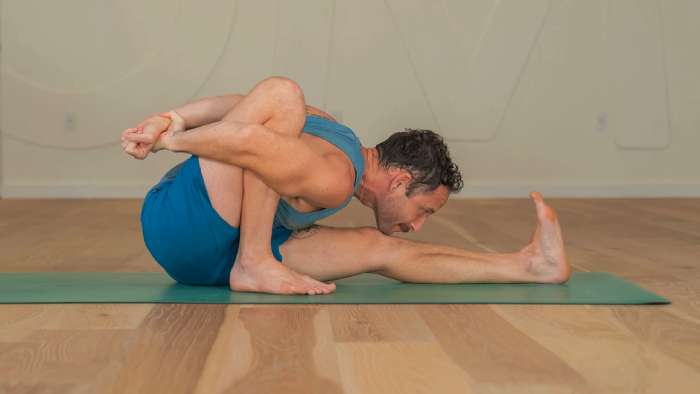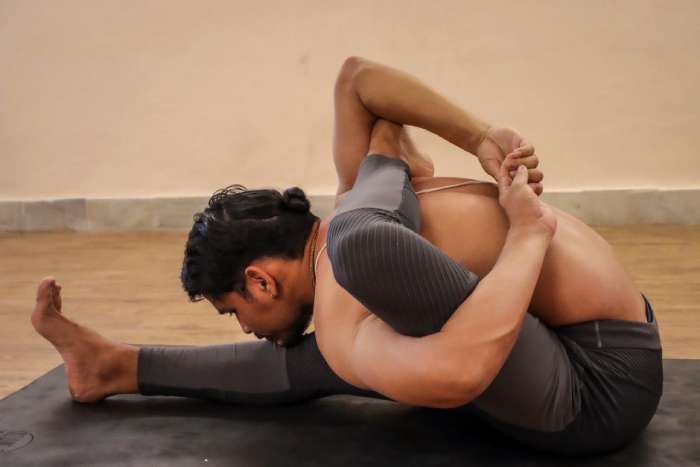Ashtanga Yoga is a physically demanding form of yoga that is particularly well-suited for men. The practice involves flowing, synchronized movements that build strength, flexibility, and endurance.
Ashtanga Yoga also incorporates deep breathing techniques and meditation, making it a holistic practice that benefits both the body and mind.
Men who practice Ashtanga Yoga often report improved athletic performance, reduced stress levels, and better overall health and wellness. Whether you’re a seasoned yogi or just starting, Ashtanga Yoga is an excellent way for men to improve their physical and mental well-being.
Contents
History of Ashtanga Yoga: Tracing the Roots of a Dynamic Practice
Discover how Ashtanga Yoga has become an increasingly popular practice among men.
This type of yoga has roots in ancient India, dating back over 5,000 years. It originated from the meditative practice of Tantra, which developed as a part of the Indian cultural heritage.
Ashtanga Yoga is based on the eight limbs of yoga, as outlined in the Yoga Sutras of Patanjali. This practice focuses on physical postures (asanas) and breath control (pranayama). It’s an intense and vigorous style of yoga that can be challenging for the average man. It’s designed to build strength, flexibility, and balance while also providing a form of mental and spiritual training.
Ashtanga Yoga has become increasingly popular among men due to its powerful combination of physical and mental exercise. Its meditation techniques have been proven to improve concentration and mental clarity, while its cultural roots provide an interesting and unique experience.
Benefits of Ashtanga Yoga: How It Nurtures?
Not only is Ashtanga Yoga a great way to get into shape, but it also offers a range of mental and spiritual benefits.
Practicing Ashtanga Yoga regularly can help to reduce stress levels, improve focus, and promote relaxation. It can also help to improve physical health, enhance strength and flexibility, and reduce the risk of injury.
With regular practice, Ashtanga Yoga can also help you to develop a deep sense of self-awareness and inner peace through meditation. Additionally, this form of Yoga can help to open up the body’s major energy centers, clearing the mind and cultivating a sense of clarity and balance.
In short, Ashtanga Yoga is an excellent way to nurture your physical, mental, and spiritual health.
Key Ashtanga Yoga Poses:
Practicing Ashtanga Yoga regularly will help you to master the various poses associated with this practice.
Ashtanga Yoga poses are sequenced, so the practice has a logical flow. You’ll use breathwork techniques to move through the poses, as well as alignment adjustments to ensure that you’re doing each pose correctly.

Poses will range from standing poses to seated poses, inversions, and twists, and you’ll be able to progress and refine the poses over time with regular practice.
As you move through the poses, your body will become stronger and more flexible, and you can go deeper into each pose while maintaining proper alignment. Additionally, the breathwork associated with Ashtanga Yoga will help to calm your mind and focus your thoughts.
Sequencing in Ashtanga Yoga:
You’ll learn how to sequence your Ashtanga Yoga practice to maximize its benefits. Timing considerations and breathing techniques are key components of Ashtanga Yoga sequencing.
When starting your practice, always consider the amount of time you have available. If you have only a short time, focus on the main poses and leave out the more advanced postures.
Don’t forget to incorporate Ujjayi Pranayama breathing techniques between postures to link your practice. For a longer practice, start with the fundamental poses and add more complex postures and variations as you progress.
Combine your breathing with your movement to strengthen your practice and deepen your connection to the pose.
With a little practice, you’ll master the art of sequencing and maximize the benefits of your Ashtanga Yoga practice.
Tips for Practicing Ashtanga Yoga:
For maximum benefit from your Ashtanga Yoga practice, here are some helpful tips to keep in mind:

- Make sure to focus on your breathing techniques. Mindfully inhale and exhale throughout your practice.
- Maintain proper alignment and keep your body in the correct postures.
- Try to maintain a mental focus on your practice. Keep your attention on the poses and your breath instead of letting your mind wander.
These are key to unlocking the full potential of your Ashtanga Yoga practice. With practice and dedication, you’ll soon be able to maximize the benefits of Ashtanga Yoga.
Frequently Asked Questions:
The best environment for practicing Ashtanga yoga is calming and quiet. Practice meditation tips, focus on your breath control, and you’ll be able to reap the rewards. Dedication, knowledge, and experience will help you get the most out of your practice.
Yes, ashtanga yoga is perfect for beginners. Its combination of physical and meditation benefits helps one build strength and flexibility while calming the mind. It’s a great way to start your journey into yoga.
As a beginner, you’ll benefit from wearing comfortable, flexible clothing while practicing Ashtanga yoga. 97% of people who practice Ashtanga experience improved flexibility and breathing techniques, so you’ll want to choose clothing that won’t restrict your movements. Be sure to stay dedicated and enjoy the journey!
It would be best to make eating habits and lifestyle changes to reap the full benefits of Ashtanga Yoga. It’s important to eat a balanced diet and avoid processed foods. Additionally, be sure to stay hydrated and get adequate rest.
“You’re in luck! Other types of yoga similar to Ashtanga include Vinyasa, Iyengar, and Bikram – all of which focus on meditation techniques, body alignment, and breath control. ‘Knowledge is power,’ so take the time to learn and understand each style to determine which is best suited to you.”
Conclusion:
Whether you’re a beginner or an expert, Ashtanga Yoga can be a great way to increase your physical and mental strength.
With dedication, knowledge, and experience, you can create a practice that’s tailored to your own needs and goals.
With the right instruction and guidance, you can reap the many benefits that Ashtanga Yoga has to offer. So why not give it a try and see for yourself?
Together, let’s explore and enjoy the journey of Ashtanga Yoga.

Hello, I’m Ravindra. Over the years, I’ve immersed myself deeply into the world of fitness and health, transforming both my body and mind. Writing has allowed me to share my journey, insights, and expertise with those just starting out and seasoned fitness enthusiasts alike. Beyond just routines and diets, I believe in inspiring others to adopt a holistic approach to well-being.
